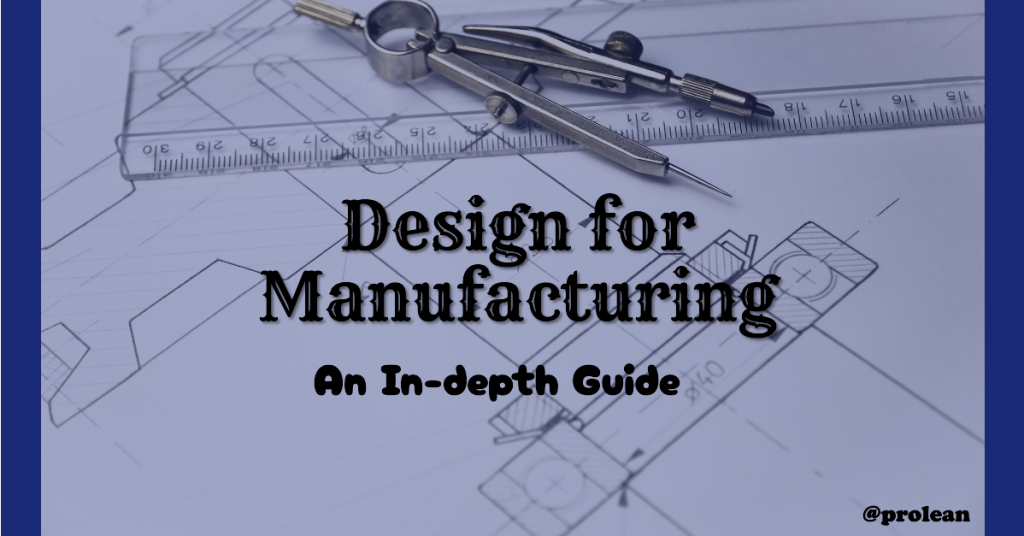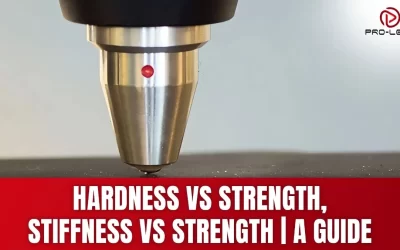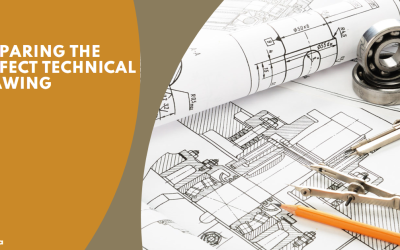“The most important point of the Design for Manufacturing (DFM) strategy is that it reduces the overall cost and increases production efficiency.”

Technical or engineering drawings are the foundation for the manufacturing of any item, regardless of which manufacturing method. CNC machining, injection molding, die casting, and every other process involves drawing a virtual design of the intended part (2D or 3D) and executing the manufacturing based on this model. Here comes the drawing strategy called” Design for Manufacturing.” This approach guides the designer in preparing a drawing so that its manufacturing will reduce the cost and maintain the required quality.
This blog post will cover design principles for manufacturing approaches with essential guidelines for preparing such designs.
What is Design for Manufacturing (DFM)?
It is the process of designing products, parts, or components to simplify the manufacturing stage. Engineers or designers optimize each feature and element to ensure the design aligns with the manufacturing lifecycle.
Meanwhile, DFM’s main aim is to ease the manufacturing process with a highly compatible design and reduce cost.
- DFM optimizes design and materials to lower costs and speed up production.
- It involves a thorough analysis of design and manufacturing processes.
- Advanced computer tools allow for detailed simulations of manufacturing.
- Its adoption is growing among manufacturers for its efficiency and innovation benefits.
Moreover, the design for manufacturability approach can implement the changes early in the design phase. Advanced software can simulate the manufacturing of designs on computers. It can give various ideas for improving the design according to the capability of a particular manufacturing technology.
For example;
If you are creating a shaft design to manufacture it with CNC milling, you can simulate the milling of that shaft in computer software. It allows you to accurately change the design for quality, cycle time, and even the parameters before proceeding with the actual milling process.
Try Prolean Now!
What are the Design for Manufacturing Principles?
Before starting the design, considering the right manufacturing method helps to decide several aspects of drawing, from tolerance levels to geometries. For example, the design of an injection mold to be manufactured with EDM or CNC might need a few separate considerations.
Furthermore, several principles can be found to make a manufacturable design. However, we will only discuss the four fundamental principles covering most DFM strategies.
1. The Design Process

CAD Design of landing gear part
The design process in Design for Manufacturing (DFM) focuses on easier designs for manufacturing. Key aspects include Correct Dimensioning to avoid ambiguous or complex measurements that complicate the production process. The uniformity in the design, such as standardized hole sizes or symmetrical layouts and simple tooling. Next, consistent thickness and seamless transition
Furthermore, the design process might differ from one manufacturing method to another. For instance, draft angle is critical in molding designs but not CNC machining.
Let’s take an example of the design process principle for a CNC manufacturing design;
- A minimum wall thickness of 0.8 mm for metals and 1.5 mm for plastics to ensure structural integrity and avoid deformation
- The depth of a hole is equal to or less than four times its diameter for stability and accuracy
- Consideration of clear tool access on the machining surfaces.
- A radius on internal corners with at least one-third of the cavity depth
2. Material selection
Choosing the material for manufacturing involves considering factors like strength, durability, weight, aesthetics, cost, and compliance with regulatory standards. Next, the materials should be compatible with the intended manufacturing process, whether casting, forging, machining, or molding.
The DFM material selection is based on the following criteria;
- It should match the product’s operational demands and lifespan, like hardness, strength, electrical & thermal conductivity, etc.
- The cost should be relatively low, either by removing the waste or using less expensive & readily available options.
- The selected materials do not compromise the product’s quality or performance.
- The material simplifies manufacturing processes and reduces production cycle time.
3. Time & Cost Minimization
Design-for-manufacturing practices streamline various stages of the product lifecycle, from design to production to assembly. They accomplish this by simplifying the design, using standard components, and optimizing assembly processes. Consequently, they also focus on reducing material waste and energy consumption to reduce the overall cost.
4. Simulation & Testing
Computer simulation of design is a new and advanced principle. It is especially beneficial for Prototype makers because they can validate their designs and anticipate potential manufacturing and operational issues with the simulation.
Simulation tools like finite element analysis (FEA) and computational fluid dynamics (CFD) can show how a product will behave under various physical, thermal, and mechanical stresses. This proactive approach helps identify weaknesses in the design, such as stress concentrations, potential fatigue failure points, and assembly issues. As a result, manufacturers can modify before costly tooling and production.
The Design for Manufacturing Guidelines
A perfect manufacturing design requires different considerations. Designers can follow specific guidelines throughout the process to achieve this.
1. Lower Parts Numbers
The total number of parts in the product design heavily influences the time and overall project budget. Lowering the number of parts in a product minimizes and simplifies the process and assembly complexity.
2. Standardize Components
Whatever product you are designing, you can look for standard components. For example, use standard bearings and seals if you design machinery equipment.
3. Design Multi-functional Parts
Parts that serve multiple functions in a design streamline the production and assembly processes. It gives the flexibility to incorporate additional features like self-fixturing to aid in assembly.
4. Optimize Fabrication Processes
Choose materials and processes that reduce manufacturing costs. Additionally, you can avoid unnecessary finish operations and fix reasonable tolerances and surface finishes.
5. Simplify Assembly Directions
You also need to consider the design for assembly. The design should facilitate the assembly in a single direction. Vertically, it is preferred to utilize gravity and simplify the assembly process.
6. Part Compliance
You can incorporate features that allow for some variance in assembly, such as chamfers or moderate radii. These features ease insertion and reduce damage risks.
7. Controlled-assembly
Using tactile sensing, vision systems, and designed-in compliance in the assembly process enhances efficiency and reduces errors.
8. Waste Minimization
Design products that consider waste, especially in subtractive manufacturing. Lower material waste contributes to cost reduction.
Try Prolean Now!
General Rules of Design for Manufacturability
- Ensure a suitable distance between holes on parts. The distance between the two centers should be three times the hole diameter.
- The base dimensional specifications should be clarified. You can use standardized dimensions from a consistent datum to prevent tolerance stacking issues.
- Lightest feasible weight while maintaining durability.
- Use standard and simple tooling setups over custom tooling unless the production scale demands it.
- Incorporate ample curve transitions like fillets and radii to enhance part robustness.
- Strategize part designs for multiple manufacturing steps without the need for reorientation.
What is Design for Assembly(DFA)?
It refers to designing the product by considering the serval factors for assembly like orientation, positioning, inserting, and fastening. Like DFM, DFA focuses on reducing assembly duration and expenses. Moreover, combining DFM and DFA in manufacturing design optimizes the final result.
It promotes;
- Fewer separate components to reduce assembly steps
- Straightforward insertion
- Simple and easy orientation for assembly
- Automated assembly techniques in the design phase for future integration
DFM vs DFA: What are the Differences?
Although both processes simplify manufacturing and complement each other, DFM and DFA differ. DFM focuses on the manufacturing process, whereas DFA focuses on the assembly phase.
Table: DFM vs DFA
| Aspect | DFM | DFA |
| Focus | Entire manufacturing process | Assembly phase of production |
| Objective | Cost-effective and efficient part production | Reduction in assembly time and cost |
| Key Consideration | Material selection, manufacturing techniques | Part count, ease of part assembly and handling |
| Benefit | Streamlined manufacturing, reduced complexity | Simplified assembly, reduced labor cost |
| Impact | Production efficiency and scalability | Assembly efficiency and speed |
We help to Optimize your design for Manufacturing at ProleanTech
Our designers and engineers are working on designing parts and products for various manufacturing needs. They work closely with the manufacturing team and clients to facilitate the seamless design and production transition. Thus, we can help to optimize your design to reduce the production cost and time.
Our manufacturing factory has CNC machining, sheet metal fabrication, and many more facilities. Our design support and consultation can reduce the cost of your project while maintaining quality and functionality.
You can upload your design and other information about its manufacturing. So, our design team can look at what we can do before proceeding with the production phase.
Try Prolean Now!
Conclusion
Design compliance with the capabilities of intended manufacturing technology is the foundation for a successful project. Several design and material considerations can optimize the production time and budget. Here, design for manufacturing or design for manufacturability addresses these considerations for quality results. It guides designers to prepare a mistake-proof design with minimal complexity and ease of manufacture.
FAQs
Can the DFM approach lower the manufacturing cost?
Yes! The DFM strategy can significantly lower manufacturing costs by streamlining manufacturing processes, reducing material waste, and improving efficiency.
What is an example of Design for Manufacturing?
An example of Design for Manufacturing (DFM) is using common and standardized components in a new product design.
How does DFM reduce the production cycle time?
Design for manufacturability reduces cycle time by simplifying designs and processes, leading to fewer manufacturing steps and less complex assemblies.
Why is Design for manufacturability essential?
It contributes to a simpler production process and enhances product quality. DFM also ensures that products can reach the market faster.




Simple and depth guide on DFM, thank you!
We are glad that you found this article informational!